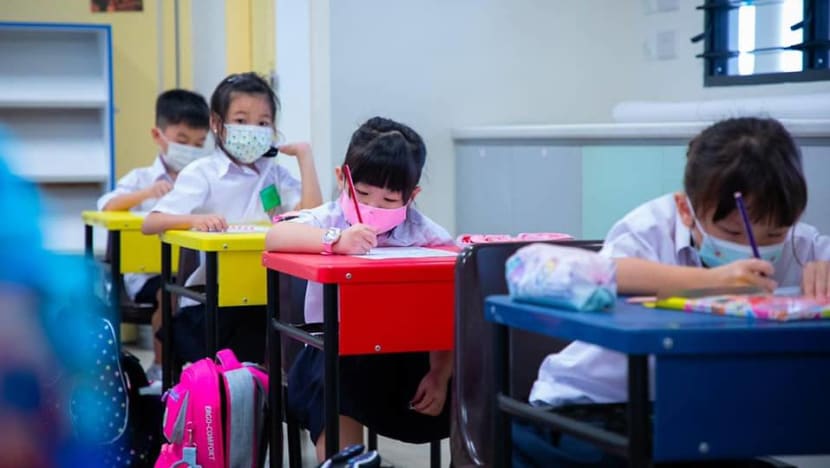Singapore students are top readers in the world, but fewer enjoy reading than in previous years: Study
Singapore took top spot in the Progress in International Reading Literacy Study, beating Ireland, Hong Kong and Russia.

SINGAPORE: Students in Singapore are the top readers in the world, an international study has found.
They performed very well in foundational and higher-order reading skills, and can confidently navigate a digital environment, said the Ministry of Education (MOE) on Tuesday (May 16) after the release of the latest Progress in International Reading Literacy Study (PIRLS) results.
They could also make simple judgments about the credibility of information and evaluate the perspective, point of view and bias in a text, said MOE.
Conducted every five years, the study measures how well students can read.
The 2021 study was conducted on a representative sample of 6,719 Primary 4 students across all 183 primary schools in Singapore from October to November 2020.
The latest list saw Singapore students in top spot, moving up from second in 2016. Ireland took second place, with Hong Kong in third and Russia in fourth.
More than one-third, or 35 per cent, of the students achieved the highest “Advanced” international benchmark in the 2021 study, compared with the international median of 7 per cent.
The improved results, despite the disruptions to school life due to the COVID-19 pandemic, signals the efforts made by schools and teachers to ensure students could continue learning throughout, said MOE in a press release.
“Despite concerns that the pandemic could have impacted the learning of P4 students from lower socioeconomic status (SES) background more so than their peers, the latest PIRLS found that the reading performance gaps between Singapore students from lower-SES homes and higher-SES homes did not widen between 2016 and 2021,” said MOE.
Singapore students were also confident in their reading ability - 84 per cent reported that they were - compared with the international average of 78 per cent, the study showed.
They also reported a higher level of engagement during reading lessons in schools in the 2021 study than in 2016.
The 2021 assessment comprised two components. Students were assessed on their reading literacy using digitised reading texts and tasks that incorporate interactive elements such as animations and hyperlinks to measure how well they read, interpret and critique online information.
In the second portion, students took a questionnaire designed to find out more about their learning contexts, including their attitudes toward reading.
A study has shown that while Singapore students are the world's top readers, the number of those who actually enjoy doing it has dropped. Richa Mathew finds out what schools are doing to address the problem.
Related:
A LOVE FOR READING
Despite topping the charts, fewer students reported enjoying reading over the years, the study also found.
The proportion of students who reported “enjoying reading a lot” fell to 51 per cent, compared with 55 per cent in 2016 and 60 per cent in 2011.
The proportion of students whose parents reported “enjoying reading a lot” also dropped to 48 per cent in 2021. It was 53 per cent in 2016 and 60 per cent in 2011.
“These observations are not unique to Singapore, and the decline in reading enjoyment may in part be driven by the rapid proliferation of other forms of entertainment and content formats (for example, social media) over the last decade,” said MOE.
At Casuarina Primary School, Primary 1 and 2 students read digital books on a platform - with the audio, or out loud and can record themselves doing so.
“The digital books are accessible from home and allow for collaboration. From our observations, the digital books excite and enthuse our students to read more,” said vice-principal Steven Wong.
“Nothing beats the sensation of touching a physical book,” he added. This is why sets of physical books are rotated across the Primary 1 and 2 classes as part of the school’s structured reading programme.
The interconnected world makes English proficiency even more necessary, said Mr Wong.
“Our understanding of literacy and linguistic skills in English has been shaped in recent years due to the rapid development in information technology. Ultimately, in this digital era, we aim to nurture not just proficient but discerning readers as well, those who possess broad worldviews by staying abreast of current events and are self-directed in the use of information,” he added.
Xishan Primary School tries to nurture and build a love for reading in students, which is “more than just building strong fundamentals and literacy”, said vice-principal Latha Sinasamy.
“In today’s digital era, I think what’s important is that students must be able to engage with texts that are multimodal in nature, that means more than just the print,” she added.
“We already know that the children are exposed to websites and information online, and this helps them to become more literate in terms of their digital literacy or media literacy skills, so that’s something that we’re trying to cultivate as well.”
For example, in the applied learning programme, students are introduced to the concept of fake news, and how to identify what information is relevant or not relevant.
“Considering that they’re younger learners, I think we try to give it to them in bite sizes,” said Ms Sinasamy.
“But it’s critical that we start from young, because by the time they pass primary school, they’ll be exposed to this more readily.”














